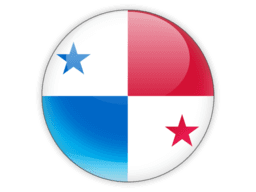
Regions of Panama
Explore 14 regions
Cities of Panama
Discover 69 cities across 13 regions
Bocas del Toro Province(4)
Chiriquí Province(8)
Coclé(6)
Colón(5)
Darién(1)
Emberá(1)
Guna Yala(1)
Herrera Province(5)
Los Santos Province(2)
Ngöbe-Buglé Comarca(1)
Panamá(21)
Panama is a country located in Central America, bordered by Costa Rica to the west, Colombia to the southeast, the Caribbean Sea to the north, and the Pacific Ocean to the south. Its capital and largest city is Panama City.
The country has a tropical climate with a rainy season from May to December and a dry season from January to April. Panama is known for its biodiversity, with over 10,000 plant species and 900 bird species. The country's geography also includes dense rainforests, mountains, beaches, and islands.
Panama has a diverse population of over 4 million people, with a mix of indigenous groups, Afro-Caribbean people, and mestizos of Spanish and indigenous ancestry. The official language is Spanish, and the currency is the Balboa, which is tied to the US dollar.
Panama's economy is heavily based on its service sector, particularly the Panama Canal, which connects the Atlantic and Pacific Oceans and is a major source of revenue for the country. Other key industries include tourism, banking, and construction. Panama also has a free trade agreement with the United States and other countries.
Panama has a democratic government, with a president and a unicameral National Assembly. The country has made strides in recent years to combat corruption and strengthen the rule of law, although challenges remain.
Panama has a rich cultural heritage, with influences from indigenous groups, Spanish colonialism, and African traditions. Folk music and dance are important parts of the country's cultural identity, and there are many festivals and celebrations throughout the year. The country is also known for its traditional handicrafts, including textiles, pottery, and baskets.
Telephone Code
507
Local Emergency Phone
Ambulance: 269-9778; Fire: 103; Police 104
Vaccinations
An International Certificate of Vaccination for yellow fever is required for travelers arriving from countries with a risk of yellow fever transmission and for travelers having transited through the airport of a country with risk of yellow fever transmission. See WHO recommendations.
Climate
Tropical maritime; hot, humid, cloudy; prolonged rainy season (May to January), short dry season (January to May)
Currency (Code)
Balboas (PAB)
Electricity/Voltage/Plug Type(s)
120 V / 60 Hz / plug types(s): A, B
Major Languages
Spanish, indigenous languages, Panamanian English Creole, Arabic, French Creole, other (Yiddish, Hebrew, Korean, Japanese)
Major Religions
Roman Catholic 48.6%, Evangelical 30.2%, other 4.7%, agnostic 0.2%, atheist 0.2%
Potable Water
Opt for bottled water
International Driving Permit
Suggested
Road Driving Side
Right
Tourist Destinations
Panama Canal; Bocas Town; Coiba Island; San Blas Islands; Santa Catalina; Panamanian coral reefs
Major Sports
Baseball, soccer, boxing, basketball
Cultural Practices
It is considered polite to refer to people by business titles, rather than their surname, when in a professional context.
Tipping Guidelines
A 10% tip is appropriate at restaurants. Taxi drivers do not expect tips.
Souvenirs
Mola- and embroidered-cloth items, woven baskets, pre-Columbian inspired gold jewelry
Traditional Cuisine
Sancocho de Gallina (Chicken Stew) - chicken, corn, and root vegetables such as ñame, yuca, and otoe, flavored with culantro (an herb similar to cilantro); typically served with a side of white rice
Geography
Area
total: 75,420 sq km
land: 74,340 sq km
water: 1,080 sq km
Climate
tropical maritime; hot, humid, cloudy; prolonged rainy season (May to January), short dry season (January to May)
Natural resources
copper, mahogany forests, shrimp, hydropower
People and Society
Population
4,404,108 (2023 est.)
Ethnic groups
Mestizo (mixed Amerindian and White) 65%, Native American 12.3% (Ngabe 7.6%, Kuna 2.4%, Embera 0.9%, Bugle 0.8%, other 0.4%, unspecified 0.2%), Black or African descent 9.2%, Mulatto 6.8%, White 6.7% (2010 est.)
Languages
Spanish (official), indigenous languages (including Ngabere (or Guaymi), Buglere, Kuna, Embera, Wounaan, Naso (or Teribe), and Bri Bri), Panamanian English Creole (similar to Jamaican English Creole; a mixture of English and Spanish with elements of Ngabere; also known as Guari Guari and Colon Creole), English, Chinese (Yue and Hakka), Arabic, French Creole, other (Yiddish, Hebrew, Korean, Japanese); note - many Panamanians are bilingual
Religions
Roman Catholic 48.6%, Evangelical 30.2%, other 4.7%, agnostic 0.2%, atheist 0.2%, none 12.3%, unspecified 3.7% (2018 est.)
Population growth rate
1.51% (2023 est.)
Government
Government type
presidential republic
Capital
name: Panama City
Economy
Economic overview
upper middle-income Central American economy; increasing Chinese trade; US dollar user; canal expansion fueling broader infrastructure investment; services sector dominates economy; historic money-laundering and illegal drug hub
Real GDP (purchasing power parity)
$126.352 billion (2021 est.)
Real GDP per capita
$29,000 (2021 est.)
Agricultural products
sugar cane, bananas, rice, poultry, milk, plantains, pineapples, maize, beef, pork
Industries
construction, brewing, cement and other construction materials, sugar milling
Exports
$27.237 billion (2021 est.)
Exports - partners
Ecuador 20%, Guatemala 14%, China 8%, United States 6%, Netherlands 6% (2019)
Exports - commodities
refined petroleum, copper, bananas, ships, coal tar oil, packaged medicines (2019)
Imports
$24.627 billion (2021 est.)
Imports - partners
China 21%, United States 19%, Japan 16%, Colombia 6%, Ecuador 5% (2019)
Imports - commodities
ships, refined petroleum, crude petroleum, tanker ships, packaged medicines (2019)
International Airports in Panama
Discover 7 major airports serving Panama
Mark Panama as Visited
Add Panama to your personal travel map and track your journey around the world. Share your adventures and see your progress grow!